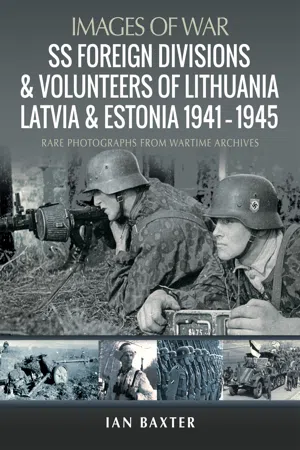![]()
Chapter One
Invasion and Occupation 1941–42
At dawn on 22 June 1941 approximately 3 million German soldiers on the frontier of the Soviet Union embarked on one of the most brutal conflicts of the twentieth century: Operation BARBAROSSA. Directing this invasion of Russia were Field Marshal Ritter von Leeb, commander of Army Group North, Field Marshal Fedor von Bock in the centre, and Field Marshal Gerd von Rundstedt in the south.
Army Group North was tasked with destroying the Red Army in the Baltic region. Hitler stipulated on the eve of the invasion that the objective was to thrust across East Prussia, smashing Soviet positions along the Baltic, liquidating the bases of the Baltic Fleet, destroying what was left of Russian naval power and capturing Kronstadt and Leningrad. Once those cities had been razed to the ground, the German armies could sweep down from the north while the main force closed in from the west. With 500,000 men at Leeb’s disposal comprising thirty divisions, six of them armoured and motorized, with 1,500 tanks and 12,000 heavy weapons, plus a fleet of 1,000 planes, he was determined to dispose of the Russian force quickly and efficiently.
Leeb’s force, consisting of the 16th and 18th armies, smashed easily through the Soviet defences on the first day. Russian soldiers stood helpless in their path, too shocked to act. Over the following weeks, troops of Heeresgruppe Nord smashed through enemy positions in Lithuania, Latvia and Estonia, straight towards their objective: Leningrad. The earth was baked hard by the summer sun and Leeb’s army was able to advance rapidly.
When German troops advanced through the Baltic States to achieve their first strategic successes, thousands of Lithuanians, Latvians and Estonians volunteered to assist them. Many saw the Nazi invasion as the beginning of the destruction of the Soviet Empire. Within days of the attack, towns and cities across Lithuania were abandoned by the Red Army as German armoured vehicles moved into suburbs and were welcomed as liberators. Similar scenes of liberation were apparent in Latvia. In Riga, the Latvian resistance began street battles against Red Army troops.
Although the Germans proclaimed that the people of the Baltic States wanted to serve Adolf Hitler, the inhabitants of the three states were actually hoping for the independence of their countries. However, the people would soon realize that the Nazis were just another occupying power, pillaging the country for their war effort. Another nasty surprise was ‘the Holocaust’, the murder of thousands of Jews, Gypsies, Russians and Soviet prisoners of war.
Yet in spite of this barbaric crusade by the Nazis, across Latvia there were thousands of people that decided to aid the German war machine by joining German organizations and military units, including the Luftwaffe. In late July 1941, just a month after the German invasion of Russia, the Germans began recruiting an auxiliary police force (Ordnungs-Hilfspolizei) of approximately 3,000 Latvian men comprising five companies. The number of police units grew over the next few months. Some fought alongside front-line German army units in Russia, others fought partisans or carried out guard or logistical duties and some rounded up and killed Jews. Latvian military leadership and Latvian civilians in the German-appointed government pushed to merge these widely-dispersed police units into a larger all-Latvian combat force.
Yet, unlike her Latvian neighbour, Lithuania had no plans to provide Germany with a National Legion of volunteers. Although within weeks of the German occupation of the country there was a large volume of volunteers that came forward, the majority of them, as many as 50,000, were slowly absorbed into German-sponsored units. In fact, many volunteers were initially deserters from the Soviet 29th Light Infantry Corps. As for the other volunteers and conscripts that came forward during the initial stage of German occupation, they comprised numerous ad hoc units formed as the Soviets were retreating. For the most part, as in the other Baltic nations, these Lithuanian ad hoc units were disbanded once the German occupation was complete. In some cases, select units provided the basis for new self-defence formations formed by the Germans for security operations.
In Estonia, when the Soviets had retreated and the country was under German administration, there was a large-scale volunteer programme recruiting Estonian men in the ranks of the Wehrmacht. Although the majority joined the German army voluntarily, often out of the desire to fight the Soviet Union, most of the newly-drafted Estonians served in the rear of the Army Group North security until the early winter of the following year.
The use of the Baltic nations as recruits in the fight against ‘Bolshevism’...
